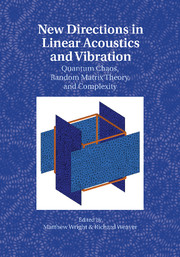Book contents
- Frontmatter
- Contents
- Foreword by Michael Berry
- Introduction
- 1 The Semiclassical Trace Formula
- 2 Wave Chaos for the Helmholtz Equation
- 3 The Unreasonable Effectiveness of Random Matrix Theory for the Vibrations and Acoustics of Complex Structures
- 4 Gaussian Random Wavefields and the Ergodic Mode Hypothesis
- 5 Short Periodic Orbit Theory of Eigenfunctions
- 6 Chaotic Wave Scattering
- 7 Transfer Operators Applied to Elastic Plate Vibrations
- 8 Mesoscopics in Acoustics
- 9 Diagrammatic Methods in Multiple Scattering
- 10 Time-Reversed Waves in Complex Media
- 11 Ocean Acoustics: A Novel Laboratory for Wave Chaos
- 12 Mesoscopic Seismic Waves
- 13 Random Matrices in Structural Acoustics
- 14 The Analysis of Random Built-Up Engineering Systems
- References
- Index
9 - Diagrammatic Methods in Multiple Scattering
Published online by Cambridge University Press: 05 October 2010
- Frontmatter
- Contents
- Foreword by Michael Berry
- Introduction
- 1 The Semiclassical Trace Formula
- 2 Wave Chaos for the Helmholtz Equation
- 3 The Unreasonable Effectiveness of Random Matrix Theory for the Vibrations and Acoustics of Complex Structures
- 4 Gaussian Random Wavefields and the Ergodic Mode Hypothesis
- 5 Short Periodic Orbit Theory of Eigenfunctions
- 6 Chaotic Wave Scattering
- 7 Transfer Operators Applied to Elastic Plate Vibrations
- 8 Mesoscopics in Acoustics
- 9 Diagrammatic Methods in Multiple Scattering
- 10 Time-Reversed Waves in Complex Media
- 11 Ocean Acoustics: A Novel Laboratory for Wave Chaos
- 12 Mesoscopic Seismic Waves
- 13 Random Matrices in Structural Acoustics
- 14 The Analysis of Random Built-Up Engineering Systems
- References
- Index
Summary
Introduction
The propagation of waves through heterogeneous media occurs in many forms, including acoustic, electromagnetic, and elastic. As these waves propagate, the wave front is altered because of spatial variations in properties. The result of the interaction with the medium is that the incident energy is dispersed in many directions – the input energy is said to be scattered. If the scattering is strong and one waits long enough, the signal received will become complex because of multiple scattering effects. Understanding this process is necessary for locating an object within a scattering medium and/or for quantifying the properties of the medium itself. The focus here is on the use of diagrams than can aid in analysis of the multiple scattering process.
Multiple scattering has been discussed by theorists since the time of Rayleigh (1892, 1945). Systems with distributions of discrete inclusions (scatterers) in a homogeneous background were studied by Foldy (1945), Lax (1951, 1952), Waterman and Truell (1961), and Twersky (1977) in terms of assumed exact descriptions of scattering by isolated inclusions. This approach may be contrasted with a model of the heterogeneous medium as having continuously varying properties. This approach entails stochastic operator theory and includes the work of Karal and Keller (1964), Frisch (1968), McCoy (1981), Stanke and Kino (1984), and Hirsekorn (1988). Both approaches seek the wave speed and attenuation of an ensemble average field, although the connection to measurements in a single sample is not always obvious.
Information
- Type
- Chapter
- Information
- New Directions in Linear Acoustics and VibrationQuantum Chaos, Random Matrix Theory and Complexity, pp. 131 - 145Publisher: Cambridge University PressPrint publication year: 2010
